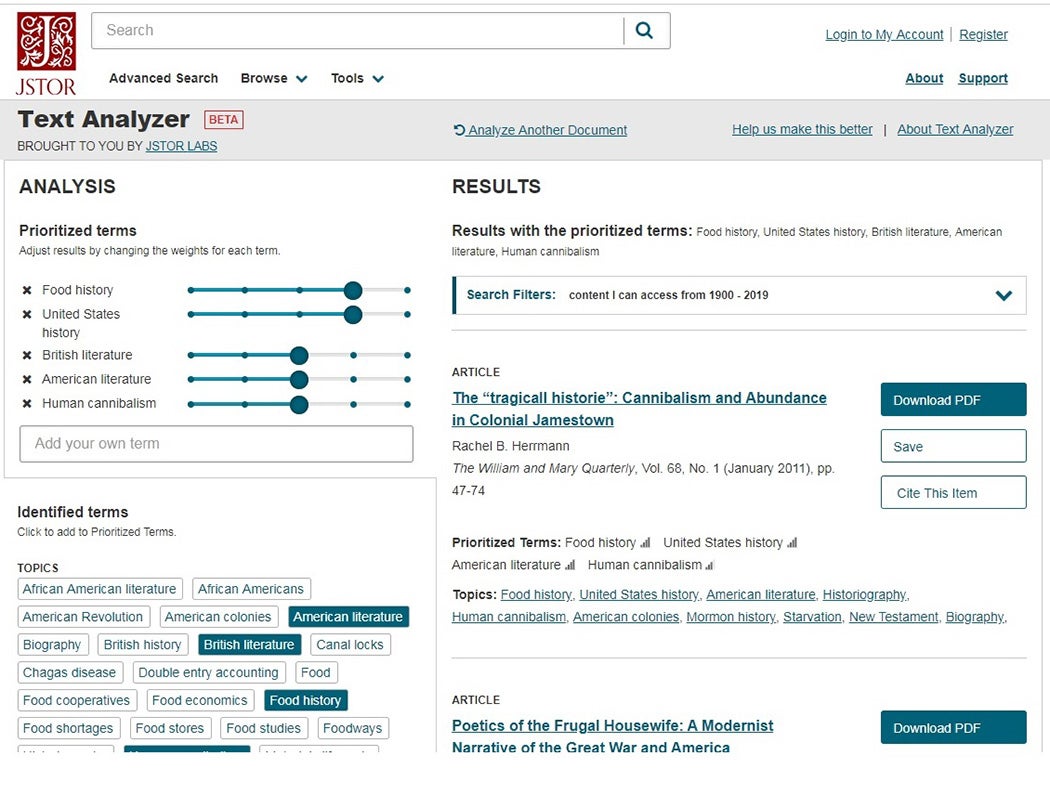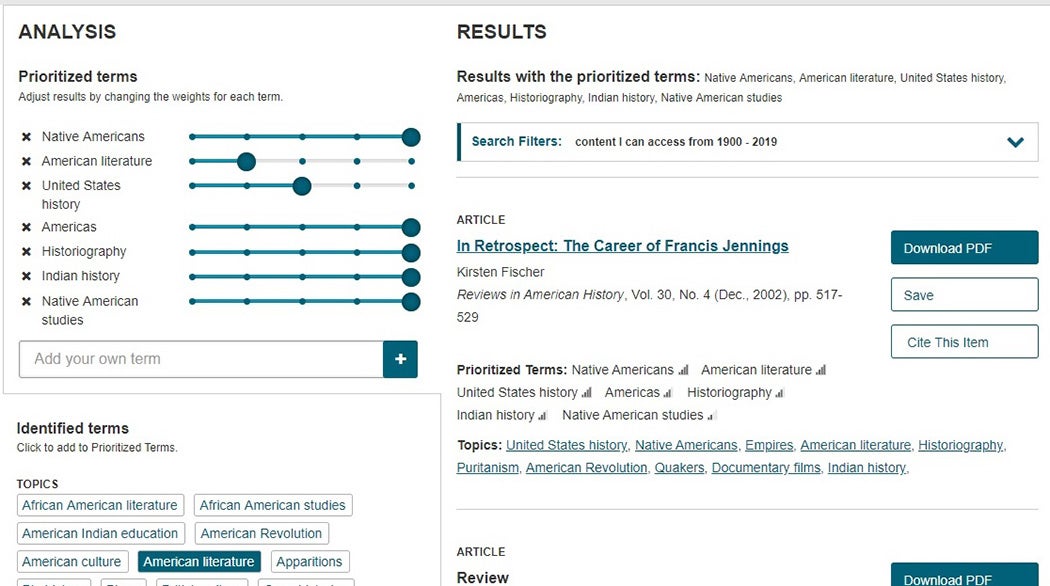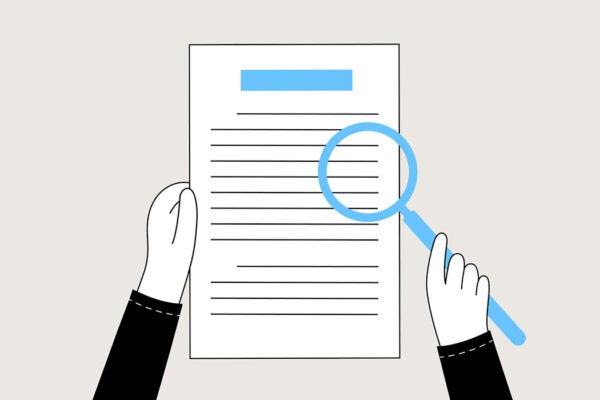Many first year undergraduates enter university not knowing how to manage their time. They have extra-curricular activities. Or jobs at the local grocery store. And then there are all those assignments—they always seems to be due at once! My students, I’ve found, need help learning how much time to spend researching, writing, and editing their assignments—and help locating the appropriate tools to do so. One of the most rewarding aspects of first year teaching is helping them develop these skills, and I’ve tried to do so especially in teaching my History in Practice class, which focuses on research methods. It’s essentially “how to be a historian” for history majors.
In teaching History in Practice, I’ve used JSTOR Text Analyzer, a research tool built by JSTOR Labs, to help students hone their researching and editing abilities. The easiest way to describe Text Analyzer is that it lets you upload files you’ve read or are working on, then uses the data in this file to provide additional reading recommendations.
Because I teach in the United Kingdom, where universities emphasize research-led teaching, I knew that I wanted to introduce an essay option that would allow students to read and write about the research interests of their seminar tutor. I wanted them to do so while developing their abilities to independently locate scholarly material for their essays. So, I wrote an essay question that asks students to agree or disagree with the argument of an article or book chapter that their seminar tutor assigns early in the semester (“seminar,” by the way, means “class session” for British students). I then created additional seminars that would help students respond to this question.
Student Assignments Using Text Analyzer
There’s a seminar where students read the article that their seminar tutor assigns, and then participate in an in-class assignment I’ve designed called “The Wandering Essay” to work out the article’s argument. And there’s a seminar where students have to locate additional reading related to that first article, with an eye toward building a bibliography. And lastly there’s a seminar where students bring an essay outline and introduction to class and workshop it with their peers.
That second seminar, where students have to locate an additional relevant reading, is where JSTOR Text Analyzer comes in. Library search catalogues can be difficult for first year students (and sometimes their seminar tutors) to navigate, and JSTOR Text Analyzer provides students with an additional resource for finding and thinking about scholarly material.
I set students up for this second seminar by giving a lecture about the department’s expectations for their essays—I discuss essay structure, writing, and editing suggestions, and the grading criteria we’ll use to assess them. I talk about reading footnotes to find related work. Then, I do a demonstration of how JSTOR Text Analyzer works. I upload the article that I teach to my seminar group, on cannibalism in colonial Jamestown. (N.B.: I conducted these searches while logged into my university’s library catalogue, so your results might look a little different.) Here’s what you get when you put my article through the Text Analyzer:

As you can see, my article on cannibalism in colonial Virginia gets tagged with topics on food history, United States history, British literature, American literature, and human cannibalism. Students might increase the importance of topics on literature (and point out that I’ve read my sources more like a historian than a literary scholar). They might increase the importance of articles on cannibalism to explain how another scientist or historian has made an argument about cannibalism that differs significantly from mine.
I can also show students how to add additional historical topics that the Analyzer misses. I can increase the importance of Native Americans (which the Analyzer mentions) and add in Native American studies (which the Analyzer does not). This tweak is particularly important because Jamestown residents reported consuming the bodies of Powhatan Indians they killed.
This lecture is followed by that third seminar on finding related readings. Students need to come to class with a print or digital copy of a related article that they’ve read, ready to discuss it with their fellow students. As students talk, I can circulate around the room to verify that what they’ve chosen is appropriate. That seminar ends with my providing additional advice about finding and analyzing a scholar’s work: looking at the first and last few pages of an article; trying to spot the moments when an author uses a lot of commas, dashes, “howevers,” and “neverthelesses” to signpost their argument; and talking about how and why historians disagree with each other.
This combination of strategies has ensured that students who submitted essays had done a bit more research and reading than they had done in previous years. And they’d done it earlier in the semester than the first years who preceded them. Their bibliographies contained appropriate citations to secondary works, rather than websites. And they got to nerd out a little bit by falling down fun research rabbit holes.
There is a lot that I like about this tool, but I don’t think that the JSTOR Text Analyzer can be taught without a discussion of its flaws. Other scholars before me have noticed that its search results tend to feature works by authors who are overwhelmingly male and white. The Analyzer reveals what scholars have already argued: that algorithms don’t eliminate bias.
This problem, however, does not seem insurmountable to me; my colleagues and I teach biased primary source material to understand how notions of race developed in early America. I could imagine an interesting seminar for advanced graduate students on digital methods discussing bias in search algorithms. Which topics get prioritized and why? Why does a Native American history class send back a prioritized term for Native American literature, for example? Recent scholarship has also emphasized the need to move beyond printed sources, to envision expansive definitions of writing to reckon with Native American Studies.
Building Syllabi with Text Analyzer
As for the Text Analyzer’s usefulness for scholars, I have found it a helpful starting point in some of my own teaching and research. You can upload your syllabi onto the site and see what happens. I uploaded mine on Native American history. The Analyzer results mean that I can see many of the topics I assigned:

Because the Analyzer included all of my extra text about ways to succeed in the module, there’s a bit too much emphasis in the search results on finding sources. I can therefore increase the importance of prioritized terms:

I can add my own terms, too. I think I’d like it even more if I could add in additional authors to address the Analyzer’s current omissions. In other words, this is a good place to start, but it’s not where I’d end if you’re trying to diversify your curriculum.
When I’m beginning to identify an appropriate journal for a piece of work I’ve written, I spend some time looking to see if that journal has published relevant articles on the same or adjacent subjects. Once I know where I’m submitting, I’ll go through old issues of the journal and check to see if there are any essays I’ve failed to cite. Text Analyzer offers an additional way to find missed articles, not only in specific journals but also in venues I might have failed to consider entirely.
Is JSTOR Text Analyzer a flawless tool? No. But it offers teachers a new way to show students research strategies. My students need that guidance on finding appropriate material, and they need to be encouraged to find that material early on in the semester. If it helps them to begin thinking about how material gets digitized, catalogued, and displayed, even better.







